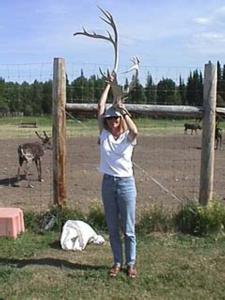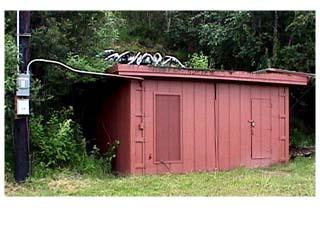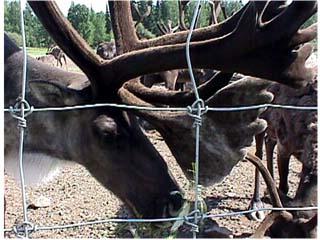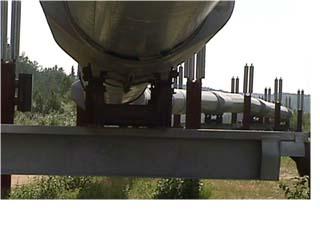15 July, 1999
Aloha from Alaska,
I had breakfast with a couple from Texas and in the course of the
coversation we all realized we were from states where a fraction of the
population wanted to cecede from the union: Alaska, Hawaii, and Texas. I
also learned that the phrase "out in the Thules" comes from airforce people
who were stationed in Thule. Greenland.
This morning Renee and I headed for the CRREL Permafrost tunnel outside
Fairbanks. It is operated by the US Army Corps of Engineers, Cold Regions
Research and Enginering Laboratory (CRREL). The site was orginally a gold
mine and then was taken over by the military and dredged into a 360 foot
tunnel into the hillside. As you wall into the entrance there is a huming
noise from the large refrieration unit that is turned on in the summer time.
In the winter large fans strategically placed inside the tunnel circulate
cold air from the outside. If these were not in use the frozen water
parcticles that are mixed in with the soil would melt and the tunnel would
collapse. There is a distinctive musty smell of frozen organic material and
a fine dust covers the shoes as you walk back in time to around 40,000 years
ago. It was dated using radioactive carbon dating of the organic debris in
the soil. Bison bones are visible in the walls as well as permafrost
structures called wedges and lenses that are large blocks of ice in those
descriptive shapes. Shelves of cores samples are laid out for research
teams to investigate paleoecologic and climatic history.
We left the tunnel remembering to turn off the lights. We did not want to
be the cause of any damage to this unique place.
In the afternoon I went to the Large Animal Research Center (LARS) which is
part of the University of Alaska. We listened to researchers talk about the
different animals that are housed there. They have musk oxen, which are
really part of the sheep family. They are an interesting species whose
tactics for survival have left them vulnerable to man. There natural
predator is the wolf. To ward off attack they form a circle with there rear
ends in the center and there large horns to the outside. When the wolves
attack they are catapulted into the air by their formidable horns. In the
book I am reading now Arctic Adventure by peter Freuchen. He talks about
hunting them for food and having to kill all of them in the circle because
they will surround and defend a fallen animal. They will not run for cover
and so the hunt is actually a butchery.
The researcher had been to Greenland and so i asked her about her
experiences there. Whe said she saw many musk oxen in the wild to observe
their behavior. Whe said they are well adapted to the high arctic and their
metabolism slows down when it gets cold. They grow a fine under hair that
they shed in the summer. This fine soft wool is sold for $145 per pound.
The farm also has reindeer and caribou. These animals were now growing
their new antlers for the year. As they grow they are very tender before
they ossify. The researcher had a bag of lichen which one of the larger
reindeer wanted to munch on. It is one of their favorite foods. But
whenever her hands would get close to the fuzzy growing antlers it would
back away. One of the interesting areas of study they are doing is on how
bone is regenerated and the hormones involved. No other animals regenerate
bone. There have also been studies in New Zealand on the health benefits
of the crushed bone which hasn't been released yet. Both areas of study have
implications for medicine. These animals are farmed for their antlers and
meat.
I then drove out to the pipeline. It was made to last around 20 years and
now is going on 29 years with only one mishap. This pipeline has poured a
lot of money into the state. This year each citizen will receive $1500, due
to the wise investment of the oil money by the government into a bullish
stock market. The construction of the pipeline over 800 miles is considered
an incredible engineering feat. It snakes into and over the permafrost
layers with out melting it which would cause a collapse of the structure.
In the late afternoon I went to the Northern Light show put on by the
University of Alaska Museum. It was well done. They used a Tesla coil as
part of a demonstration and I surprised the lecturer by knowing its name,
which only my students will probably appreciate. I learned that ionized
Nitrogen and Oxygen in the atmosphere contribute to the blue purple and
green orange colors produced and that they don't get more intense as one
goes farther north. In fact the best place to view them is about 100 miles
north of Fairbanks. Greenland is quite a bit more that that and so I am a
bit dissappointed that I may miss that phenomenon. Altho in my book,
Freuchen saw them on a Christmas eve near Thule and so may be.

I am holding up a discarded antler of a caribou which is quite heavy.

The shed that houses the entrance to the CRREL tunnel. Notice the large refrigeration tubes on the roof.

I standing at the entrance to the CREL tunnel. Notice the fans for air circulation.

The caribou especially like to eat lichens.

The pipeline; notice the weather vane structures for dispersing heat.
Contact the TEA in the field at
.
If you cannot connect through your browser, copy the
TEA's e-mail address in the "To:" line of
your favorite e-mail package.
|
